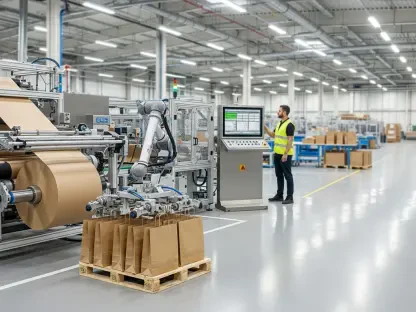In an era where automation and advanced manufacturing define global economic power, the United States finds itself trailing behind China in the critical field of robotics, a disparity that could reshape industries and national competitiveness for decades to come. China’s remarkable ascent as a robotics powerhouse, holding over half of the world’s industrial robot installations, stands in stark contrast to the slower progress seen in the U.S. This gap is not merely a matter of numbers but reflects deeper systemic differences in investment, policy, and innovation ecosystems. As China continues to solidify its dominance with massive financial commitments—nearly $137 billion pledged for robotics and artificial intelligence over the next 20 years starting this year—the urgency for the U.S. to respond has never been greater. Bridging this divide requires more than technological advancements; it demands a comprehensive strategy that addresses supply chains, talent development, and market deployment. This pressing challenge sets the stage for a deeper exploration of actionable solutions.
China’s Dominance in Robotics
China’s position as a global leader in robotics is undeniable, with the nation surpassing traditional powerhouses like the U.S., Germany, and Japan in automation density. Reports from the International Federation of Robotics highlight that China accounts for more than half of all industrial robot installations worldwide, a staggering achievement that underscores its strategic focus on advanced manufacturing. This dominance is fueled by a robust combination of government support and private sector innovation, creating an ecosystem where robotics companies thrive. The scale of investment is particularly striking, with billions allocated to research and development, ensuring that Chinese firms remain at the forefront of cutting-edge technologies. Beyond sheer numbers, the speed at which China has scaled its capabilities signals a long-term vision to maintain this lead, posing a significant challenge for other nations. For the U.S., understanding the mechanisms behind this success is crucial to crafting an effective response that can compete on a global stage.
Equally important is the role of policy in China’s robotics surge, as the government has made automation a national priority through incentives, subsidies, and infrastructure development. This deliberate approach contrasts sharply with the more fragmented efforts seen in the U.S., where policy often lags behind industry needs. China’s ability to rapidly deploy robots across diverse sectors—from manufacturing to logistics—demonstrates a level of coordination that amplifies its competitive edge. Additionally, the focus on integrating artificial intelligence with robotics has positioned Chinese industries to adapt swiftly to emerging trends. For American stakeholders, this serves as a wake-up call to align governmental and private initiatives more effectively. Without a unified strategy that mirrors China’s commitment, the U.S. risks falling further behind in a field that increasingly defines economic and technological superiority.
Strategies for U.S. Competitiveness
To counter China’s lead, the U.S. must prioritize the creation of a supportive ecosystem for robotics innovation, starting with substantial investments in research and development. Federal funding for robotics programs, coupled with tax incentives for companies adopting automation, could spur growth in this sector. Collaboration between universities, private enterprises, and government agencies is essential to drive breakthroughs in technology and ensure that innovations move quickly from labs to market. Strengthening domestic supply chains for robotics components is another critical step, as reliance on foreign suppliers often hampers speed and scalability. By fostering a culture of innovation through grants and partnerships, the U.S. can nurture startups and established firms alike to compete globally. Events like RoboBusiness, where industry leaders convene to discuss such strategies, provide valuable platforms for brainstorming and networking, helping to shape a cohesive national approach to automation challenges.
Another vital aspect of closing the gap lies in addressing the talent shortage that plagues the U.S. robotics industry, an area where China has made significant strides through education and training programs. Developing a skilled workforce requires a concerted effort to integrate robotics and STEM education into school curricula at all levels, preparing the next generation for careers in automation. Partnerships with technical colleges and vocational programs can further bridge the skills gap, ensuring a steady pipeline of qualified engineers and technicians. Additionally, immigration policies that attract global talent could bolster the industry’s capacity for innovation. Unlike China’s centralized approach to workforce development, the U.S. must leverage its diversity and entrepreneurial spirit to create flexible, adaptive training models. By prioritizing human capital alongside technological investment, American robotics can build a foundation for sustainable growth and competitiveness in the global market.
Building Global Collaboration
While competition with China is inevitable, there is also room for strategic collaboration that could benefit the U.S. robotics sector in unexpected ways. Engaging in joint research initiatives or partnerships with Chinese firms, where feasible, can provide access to cutting-edge technologies and vast markets, fostering mutual growth. Industry experts, such as those speaking at key forums like RoboBusiness, have noted that China’s advancements offer opportunities for learning and adaptation rather than just rivalry. Establishing international standards for robotics development, with input from multiple nations, could level the playing field and encourage fair competition. For the U.S., such collaboration must be balanced with protecting intellectual property and national interests, ensuring that partnerships enhance rather than undermine domestic capabilities. This dual approach of competition and cooperation could pave the way for a more dynamic global robotics landscape.
Beyond direct partnerships, the U.S. can strengthen alliances with other regions like Europe and Japan to counterbalance China’s influence in the robotics market. Creating coalitions focused on shared innovation goals—such as developing sustainable automation solutions or addressing ethical concerns in robotics—can amplify collective impact. These alliances could also facilitate knowledge exchange and resource pooling, enabling smaller players to compete with China’s scale. A notable emphasis should be placed on localized strategies that adapt global best practices to American contexts, ensuring relevance and effectiveness. By positioning itself as a leader in such collaborative efforts, the U.S. can regain ground while fostering a more interconnected industry. This multifaceted approach underscores the importance of looking beyond national borders to build resilience and innovation capacity in the face of China’s robotics dominance.
Paving the Way Forward
Reflecting on the robotics disparity, it becomes evident that the U.S. must confront significant challenges to match China’s strides in automation over recent years. Discussions held at events like RoboBusiness have proven instrumental in highlighting actionable paths, from boosting investments to fostering talent. Moving forward, a renewed focus on policy alignment and public-private partnerships should guide efforts to revitalize the American robotics sector. Encouraging cross-sector collaboration and incentivizing rapid commercialization of new technologies remain critical steps to regain momentum. Additionally, maintaining an open dialogue with global counterparts can help navigate the complexities of competition and cooperation. As the landscape continues to evolve, the lessons learned from past gaps must inform a proactive stance, ensuring that the U.S. not only catches up but also sets new benchmarks for innovation in robotics on the world stage.









